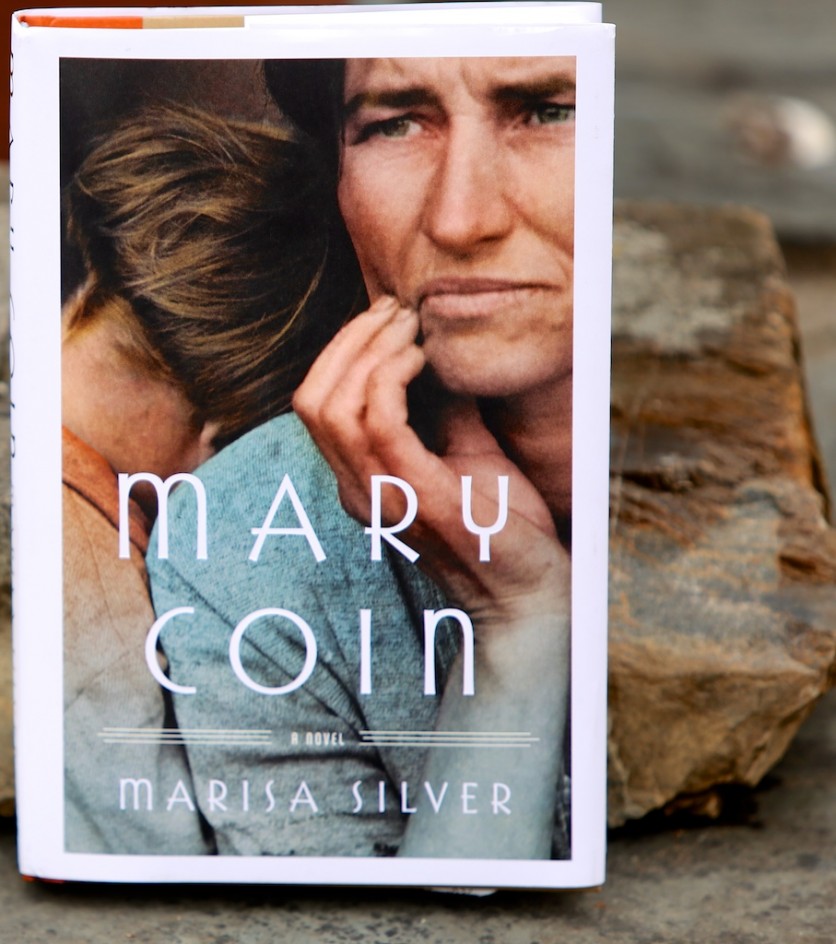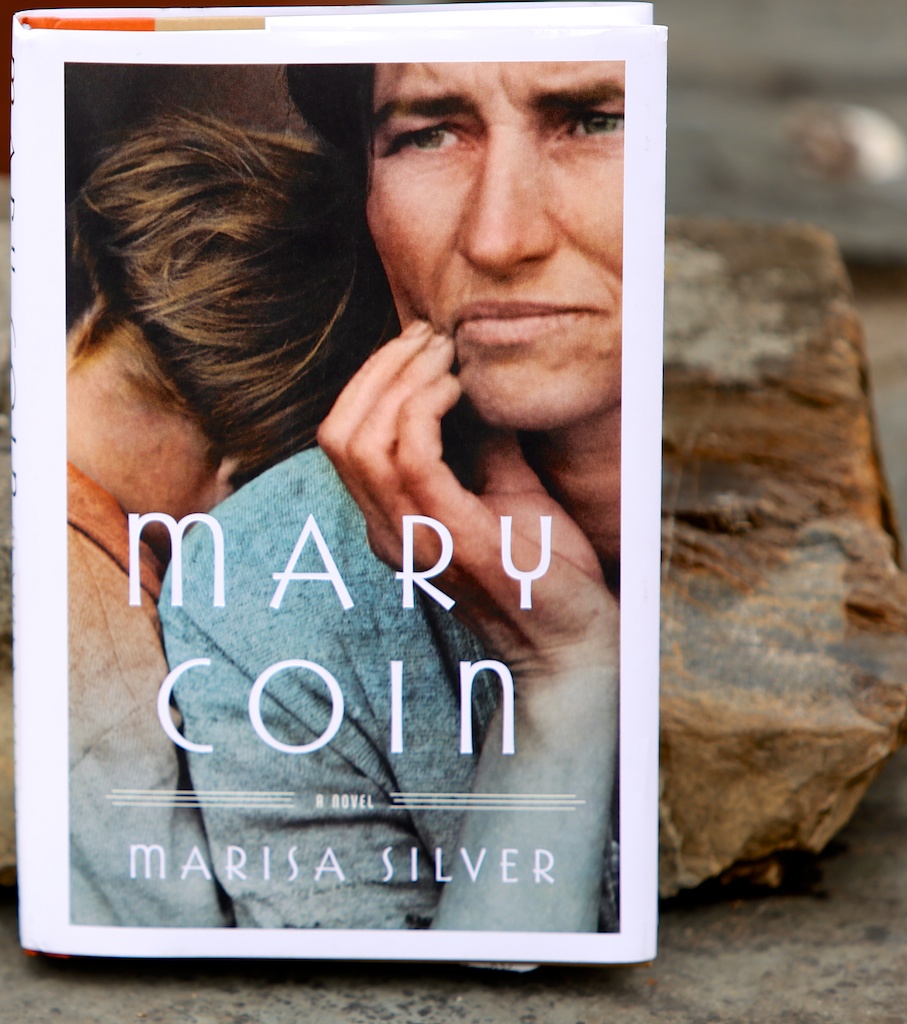
If you wish to buy this book, please consider purchasing it from Battenkill Books (518 677-2515) or e-mail [email protected] or from your independent bookstore. Battenkill Books is my local bookstore and I am their Recommender-In-Chief, thus these reviews. I will also sign and personalize any of my books purchased through Battenkill, and thanks for helping a wonderful local bookstore thrive.
–
Mary Coin (Blue Rider Press) is an absolutely beautiful, wrenching and very compelling story of two strong and remarkable women who met in a California pea field during the worst of the Great Depression, making history and changing both of their lives forever. The photograph on the cover of the book was taken (in black and white) by the great photographer Dorothea Lange in 1936 in Nipomo, California, and it was the inspiration for this novel. Lange was photographing migrant labor camps for the federal government. The photograph she took was of a woman named Florence Owens Thompson and her seven children. Thompson, recently widowed, was living in a lean-to near a pea field. She was absolutely desperate. Her children were living on frozen vegetables and dead birds. She had just sold the tires on her car for food. The photograph is called “Migrant Mother.” It became one of the iconic and enduring images of suffering during the depression and made Lange one of the best known photographers in the nation.
It also sparked this great and fictionalized story of two people, one famous and the other forgotten, and of the enduring legacy sparked by their chance encounter. I think women will especially love the main characters, who so bravely struggle with love, marriage, suffering, men and different notions of work.
In the novel, Florence Thompson becomes Mary Coin and Lange is Vera dare. Although it is inspired by real events, it is very much a novel, not a non-fiction recounting.
In Mary Coin, Dare is more fortunate and privileged than Mary Coin, but her life is not simple or easy. A victim of polio when she was a child in New Jersey, she has a crippled leg and a bad limp that does not keep her from getting to San Francisco and starting a career as a society photographer. She meets and marries an older man, an artist, who is remote and unfaithful despite their having had two children together. Both of these women end up on their own.
Coin fled the farms of the Dust Bowl with her husband and made it to the California migrant labor fields as the depression deepens. Her husband is stricken with tuberculosis and dies in her arms and she is left alone with seven children, little work, and no food or savings. She is completely at the mercy of the men who hire workers, but she never surrenders her pride to them. She does do one thing out of desperation that she will regret her whole life. Her encounter with Dare is a chance encounter, neither woman knows a thing about the other. Dare takes five images of Thompson and moves on, but each is haunted by the encounter and has reason to remember it all of their lives. (Lange recalled that she approached Thompson “as if drawn to a magnet.” Neither asked any questions of the other, but both, said Lange, sensed that they could help each other.)
The novel is rich, fast-paced, just wonderfully plotted and written. There is a third character in the book, a professor of cultural history named Walker Dodge who discovers a family mystery embedded in “Migrant Mother,” but he is greatly overshadowed by the very powerful characters of Dare and Mary Coin, each ferociously devoted to their children in very different ways. The book captures the emotional intensity of motherhood – the longing, guilt, doubt and love – in the most grateful but truthful of ways.
In the novel, Mary Coin is aware of the image Lange took, it followed her through her life, although almost no one around her ever recognized her from it, apart from her family. Her life remains a modest one. In the novel, Dare writes a letter to Thompson that she carries around for the rest of her life. “There is a sense you get when you have taken the right photograph,” Dare wrote Thompson. “It is a feeling that you have lived that second of your life more completely than any other. The moment opens, and you realize how much larger your life is than you thought it was, how much closer to a kind of…it is happiness? I don’t know.” This is as wonderful a description of taking the right photograph as I have ever heard.
I should say that photographers will love this book as well as people who love good writing, because it so wonderfully captures the randomness and meaning of the image. Most great pictures are chance encounters, I find.
Silver does a wonderful job with this book, inspired by the great photograph but not trapped by it. This story thrives on its own. Both of these women are stirring and admirable, determined and passionate. Between them, they embody the best of the feminine spirit in very different, yet not-so-different ways. Dare is a strong and famous working woman, fearless and focused. Coin is determined that she and her children will survive unspeakable poverty and suffering. Almost on strength of will alone, she carries them through. There is much that is heroic about both of them. There seems to always be much hand-wringing about a woman’s place in at home or at work and “Mary Coin” shows us – without ever lecturing us – that powerful women exist in both places. The story leads us to the photograph, and then follows each of these woman through the rest of their lives, including a very poignant scene where Mary struggles through a chronic illness to get herself to San Francisco to see an exhibit of Dare’s work and finds herself face-to-face with her own image.
You might have some tissues ready for that encounter. I loved this book and highly recommend it. There is no reason why men would not love it also, but I think it speaks to the female experience in the most poignant and powerful of ways.
–
If you want the book, think about getting it from Battenkill. [email protected] or call 518 677-7136.

